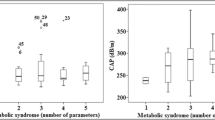Abstract
Objective
To explore the relationship between the liver fibrosis criteria and TCM Syndrome type in patients suffering from non-alcoholic fatty liver.
Methods
Seventynine patients with non-alcoholic fatty liver diagnosed by B ultrasonography were classified by TCM Syndrome Differentiation and their liver fibrosis criteria was determined and compared with those of the healthy subjects as control.
Results
Levels of procollagen I (PCIII), hyaluronic acid (HA), collagen IV(CIV) and laminin (LN) in the fatty liver group were significantly higher than those in the control group (P<0.05,P< 0.01). In respect to the TCM Syndrome-types, PC III, C IV and LN in patients of Phlegm-stasis combined type were significantly higher than those in patients of Spleen deficiency-Phlegm dampness Syndrome-type and Damp-Heat Syndrome-type (P<0.05,P < 0.01), while HA in different groups was insignificantly different (P> 0. 05 ).
Conclusion
There was trend of liver fibrosis in fatty liver patients. It was indicated that the Phlegm-stasis combined Syndrome-type possibly was the main TCM pathologic factor of the increasing of fibrosis criteria for non-alcoholic fatty liver.
Similar content being viewed by others
Author information
Authors and Affiliations
Rights and permissions
About this article
Cite this article
Deng, Yq., Fan, Xf. Relationship between liver fibrosis criteria and syndrome-type of TCM in patients with non-alcoholic fatty liver. CJIM 7, 260 (2001). https://doi.org/10.1007/BF02934365
Issue Date:
DOI: https://doi.org/10.1007/BF02934365




